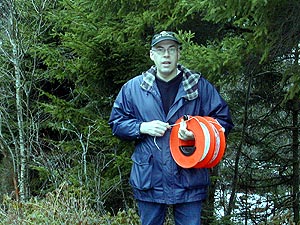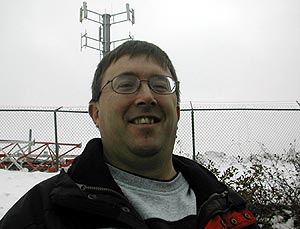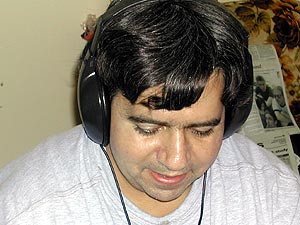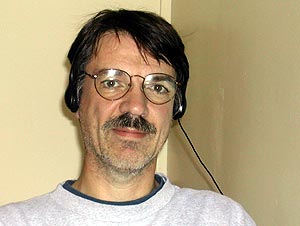|
Newfoundland DXpedition 11
November 1 to 10, 2002
by Jean Burnell
The eleventh DXpedition to Cappahayden,
Newfoundland, posed new logistical problems. Previously,
I had lived only 100 km away in St. John's, but
I had taken a new position at Dalhousie University
in Halifax, Nova Scotia, over the summer. This time,
I was flying to Newfoundland, like the other DXers.
A couple of kilometres of wire, a hundred metres
of coax, splitters, switches and other hardware:
this is pretty heavy for air travel. I was worried
that the airline would object to the outrageous
weight of my luggage.
"How many bags to check
in?" the petite CanJet ticket agent asked.
I indicated two, a large suitcase and a very large
box. I did not volunteer that they weighed more
than she did. Then, ticket in hand, I scurried towards
the departure area with my Drake R8A under my arm
before I was called back to explain the weighty
baggage. The flight to Halifax was uneventful, and
my suitcase and box arrived as well. Unlike in previous
years, I had to use valuable time to pick up a rental
car, buy ground rods at a hardware store, fill a
large container with drinking water at my ex-neighbour's
house in St. John's, and buy groceries.

Jean Burnell |
I managed to get to the DX site
in Cappahayden by the middle of the afternoon. What
calamity the old "DX Inn"? The lawn was
littered with broken toys, pieces of rotten wood
filled with rusty nails, pieces of sodden cardboard,
and a piece of seal blubber that I presumed was
meant to sustain the forlorn black dog. Floorboards
had rotted on the deck, and there was a ragged hole
though the deck with a diameter matching, probably
not by coincidence, the diameter of average human
hips. The key did not work properly on the back
door, so I had to make my way through the front
of the house. It was not locked, and there was nobody
at home.
Inside our bedroom and shack
area, an extension at the back of the house, there
were more unpleasant surprises. I phoned the owners
at their home in Cape Broyle. The owners did not
seem to be surprised or concerned that someone had
walked away with three of the five beds. They had
given the place to their son, and he clearly had
no interest in maintaining it. We were going to
have a less than comfortable time, but I was very
relieved that at least my two folding tables, which
I had kept for six or seven years at the DX Inn,
had not been pilfered. They were leaning against
the wall of the first bedroom. I dropped my suitcase
in that bedroom, and pulled a spool of wire from
the gargantuan box. I had to make the most of this
situation, so I raced outside to get an antenna
up before dark. I did manage to deploy about 600
metres of a southern Beverage along the beach.
The dog, who seemed amazed that anyone should offer
him any attention, came along to bark at the seals
and the gulls. (He was later rewarded with slices
of ham.) Back in the cold shack - why wouldn't the
heat come on in some of the rooms? - reception conditions
seemed to be at best fair. There were some signals
at decent levels coming from Brazil, but these were
dogged by very heavy thunderstorm noise. Signals
from the Plata region were uncharacteristically
weak, and remained so throughout the DXpedition.
Even stations like Radio Del Plata (1030 kHz) that
had always been very strong were inaudible that
night and for most of the week.

John Fisher |
John Fisher (Kingston, Ontario)
arrived while I was asleep, at around 3:30 in the
morning. He climbed wearily under to covers of the
other bed, and froze. He had innocently bunked in
one of the unheated rooms.
I was much better rested than
John was the next morning when we extended the southern
Beverage to its usual length, one kilometre, and
terminated it. We then set up a 350-metre terminated
antenna towards Europe. The European antenna happened
to be aimed "off the back" towards the
southwest, which in later days led to some welcome
catches from that direction just before our sunrise.
John set up his Drake R8, and
we switched on the receivers a few hours before
sunset. Neither antenna produced much excitement
on medium-wave that evening. Signals from northern
Europe were weak; Iberian pests dominated. Once
again, high levels of noise made reception of Brazil
difficult, if not painful, on our southern antenna.
John and I drifted up to higher frequencies to listen
to Indian and Chinese stations on 60 metres and
to the many European pirates in the "48 metre-band."
The weather, which had been quite pleasant during
the day, became extremely unpleasant during the
evening. Until the last day of the DXpedition the
weather was "normal" for that time of
year in eastern Newfoundland. It ranged from poor
to appalling. The European wire was broken twice
by the high wind and heavy surf.

Neil Kazaross |
Neil Kazaross (Barrington, Illinois)
drove his rented car from St. John's though a blizzard
to arrive in Cappahayden late that night (November
3rd). He recounted the close calls he had had on
his harrowing drive as he set up his Drake R8A and
his unique phasing unit.
He attacked the Brazilian signals,
and was disappointed in their levels. Over and over
it was the same story. A massive static crash would
obliterate the feeble signal just when we knew it
was finally IDing. Overall, we did not unearth the
number of "new" Brazilians that our joint
efforts deserved!

Jim Renfrew |
Jim Renfrew from Rochester, New
York, arrived on November 4th. We extended a shorter
wire (approximately 100 metres) southeast, towards
Africa. This turned out to be mainly a waste of
time, although I think Neil used this wire as a
counterpoise in attempts to reduce some QRM by phasing.
Jim set up his Drake R8 and DXP-4 phasing unit,
and he set out once again to prove that he can be
more sleep-deprived than any other DXer. It was
easier for him to avoid sleeping during this DXpedition
than on any previous DXpedition - Jim did not have
a bed. Jim and John slept on the floor in sleeping
bags. Neil appropriated the bed in the room with
no heat. I alone luxuriated, guiltily, in a bed
in a room that was not hovering near freezing. I
thought it would placate the others when I told
them that my mattress was a little too soft. The
others still don't believe my choice of that room
had been purely by chance!
Propagation remained poor during
the evenings of November 3rd and 4th. Signals from
the east were weak, and reception from the south
was marred by terrible noise. I only logged one
"new" station from the "Deep South,"
which is our euphemism for the Argentina-Uruguay-Paraguay
region, and that was the new Argentinean X-bander
Apocalipsis II on 1690 kHz. When medium-wave was
not producing anything useful, Jim maintained his
spirits by logging long-wave beacons, and some of
these were excellent catches.
Conditions were somewhat improved
for transatlantic signals on November 5th we were
hearing many British local stations. Nevertheless,
all of these had been logged previously from Newfoundland,
although there were some changes in slogan and one
change in frequency (BBC Somerset Sound, now on
1566 kHz). Radio Caroline from Ireland on 1593 kHz
was a "new" catch. We noticed that the
French transmitter on 1377 kHz was cutting in and
out. The people of Lille may have been deprived
of their late-night listening, but in Newfoundland
four DXers were cheering. We logged the 80-watt
Asian Sound Radio with unprecedented clarity. Some
stations from further away were also getting stronger.
We landed some Russians, and I was pleased finally
to have the opportunity to untangle the Romanian
signals on 1593 kHz. Arutz Sheva on 1143 kHz was
heard for the first time, too. Herman Boel's excellent
"European MW Guide" once again proved
to be immensely useful.
Some of the noteworthy catches
from the Americas included an off-frequency Haitian,
Radio Guinen on 1029.90 kHz, far from its nominal
frequency of 1050 kHz, and Radio VEA on 1570 kHz.
The latter was heard "off-the-back" of
the European antenna. Central America is a very
tough region to hear from Newfoundland. This was
only the second Guatemalan ever heard from Newfoundland
on MW.
John Fisher had to leave a day
before the rest of us. His return was made especially
exciting in Halifax. (He explains below.) On the
morning of November 10th Neil had to leave to catch
his flight to Chicago. The weather improved dramatically,
so bringing in the wires should not have been arduous,
but I inadvertently made it so for Jim. I had forgotten
to tell Jim that I had tied the far end of the European
antenna to a scrawny conifer half way up (or down)
a precipice. We packed the two folding tables in
their boxes, and leaned them against the wall of
the bedroom. (I never saw them again.)
On the return trip, the airline
once again had no objection to my ridiculous luggage.
In Halifax, there was snow on the sides of the roads
from the blizzard of the previous days, but everything
had been cleared up. My wife, who I thank for allowing
me to disappear for a week, picked me up at the
airport. It was back to normal life, where DX highlights
consist of stations that are garbage QRM in Cappahayden.
What was depressing about this DXpedition was not
that we had encountered below-average conditions.
In spite of the poor propagation and the privations,
the DXpedition had been tremendous fun. What was
of concern was that we no longer had a venue for
another Newfoundland DXpedition. We had all agreed
that we could not return to the DX Inn. I hoped
this would not mean the end of the Newfoundland
DXpeditions, but I was not optimistic.
John Fisher wrote:
Although this was my fifth Newfoundland
DXpedition, they continue to remain the highlight
of my often sporadic DX season. I have come to view
these events much like some folks view their annual
trips to a hunting camp - a chance to get together
with friends once a year to do something that we
often have little time to do through out the rest
of the year, swap stories and generally enjoy each
others' company. And, oh yes, the Spartan accommodation
conditions that we have are increasingly becoming
more like those of a hunting camp.
Having been to Newfoundland for
several of these adventures means that it is becoming
an increasing challenge to hear new stations (a
rather pleasant challenge I must say), but there
is always something new to try for depending upon
where signals are propagating from. During the first
couple of times that I was there, it was like being
a kid in the candy store; there were just so many
new things to hear. Now, we find that we tend to
pass by the "easy stations" (only from
Newfoundland would I say that these are easy!) such
as Belgium, Azores, and Italy, and focus on fewer,
but harder, targets. The logs reflect this focus,
I think.
On the whole, we found medium
wave reception probably a little poorer than normal.
For the first few days, the usual reception of low
powered British regional stations was almost non-existent,
however, not much else was popping up on their normal
channels to take their place. But by Nov 5 they
were starting to make their appearance with loggings
of the 200 watt Irish relay of Radio Caroline on
1593 and the 80 watt Asian Sound Radio on 1377 thanks
to France having transmitter problems. Other highlights
for me were finally getting a solid, clear log of
Kenya on 1386 and hearing the AFN station in Keflavik,
Iceland on 1530.
As I was there over a Sunday
morning UTC, I made it a point to try for some European
pirates in the 48 meter shortwave band and boy were
they audible! I heard many new stations and had
several other unidentified stations that I am still
trying to ID from the tapes.
Unfortunately, I had to leave
one day earlier than originally planned due to an
upcoming business trip, and that was an adventure
of its own. I had to layover for the night in Halifax
and managed to have this coincide with Halifax's
first snowstorm of the season. I am not sure which
was the best part: packing my clothes at 4 am in
darkness since half the city had been hit with a
power failure, walking down 15 flights of stairs
with all my radio luggage because the elevators
weren't working, the 2.5-hour bus ride to the airport,
having the bus go off the icy road into the ditch
or finally reaching the airport and finding out
that all flights had been cancelled anyways! Fortunately,
I did get home, only several hours delayed.
Jim Renfrew wrote:
My airline did not go bankrupt
the day before my journey began (as it did last
year!), so from the start this was a much better
experience. Who could have imagined that I would
be in Newfoundland DXing in my fifth year since
1995? However my status as a Newfoundland veteran
appear to have weathered my youthful features, as
the cashier at Zellers asked to see my "senior"
card for a discount! I'm only 48, so let's not rush
things, please! Other than the lack of a bed to
sleep in, the rest of the week followed the usual
Cappahayden routine: up all night, sleep at dawn,
go out for lunch, and then back to the dials as
the first TA signals begin to roll in around 2:30
pm with the sun still high in the sky.
Crossing the border back into
the US at Lewiston NY resulted in a trunk search
(my first), and a brief conversation about radio
equipment. I probably told the border agents more
than they wanted to hear about my reasons for visiting
Canada. Then they asked me why I hadn't registered
the equipment with US Customs before crossing over
to Canada. I explained that I had never heard of
such a thing, and that seemed to satisfy them. So
it looks like that's what I'll do next time. But
after thinking about it, I wonder if they mistakenly
concluded that I was an amateur operator.
As far as DXing, it's not as
easy to find new ones, now that we have picked off
all the easy targets through the years. So, as is
the case at home, DXing takes a lot of digging (looking
for that weakest of the three programs on a channel),
patience (hoping for the fade-in to occur at the
top of the hour), and luck (such as French and Irish
stations going off the air with transmitter problems).
Enhancing our chances, of course, is the teamwork
that gets multiple ears working on an elusive signal,
along with the rich repository of DX knowledge in
the room.
During quiet moments, I
did some longwave beacon DX'ing, and the TA, Caribbean
and South American stations heard were very encouraging.
The highlight was ASN from Ascension Island, also
heard by the group in Miscou NB in September.
 DXpedition Log
DXpedition Log
Published
on DXing.info on March 7, 2005
  
|